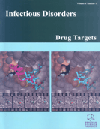- Home
- A-Z Publications
- Infectious Disorders - Drug Targets (Formerly Current Drug Targets - Infectious Disorders)
- Previous Issues
- Volume 9, Issue 5, 2009
Infectious Disorders - Drug Targets (Formerly Current Drug Targets - Infectious Disorders) - Volume 9, Issue 5, 2009
Volume 9, Issue 5, 2009
-
-
Editorial [Hot topic: Structural Genomics (Executive Editor: Yu Wai Chen)]
More LessBy Yu W. ChenIn the wake of the “post-genomic” era, a major shift in research strategies against infectious diseases is emerging— from the traditional approach that has based on “playing defensive” to one that is “taking offensive” against the pathogens. With modern high-throughput technology, complete genomic information contents of major pathogens are being deciphered one by one (refer to the Genomes OnLine Database v2.0 at htt Read More
-
-
-
Benefits of Structural Genomics for Drug Discovery Research
More LessWhile three dimensional structures have long been used to search for new drug targets, only a fraction of new drugs coming to the market has been developed with the use of a structure-based drug discovery approach. However, the recent years have brought not only an avalanche of new macromolecular structures, but also significant advances in the protein structure determination methodology only now making their wa Read More
-
-
-
Advances in Mycobacterium tuberculosis Structural Genomics: Investigating Potential Chinks in the Armor of a Deadly Pathogen
More LessAuthors: N. Chim, L. M. McMath, M. Beeby and C. W. GouldingThe waning effectiveness of established tuberculosis treatments due to the rise of multi and extensively drugresistant strains of Mycobacterium tuberculosis, coupled with the synergism of HIV infection, demands basic research efforts to inform focused drug development programs. Structural genomics projects provide rich sources of information for the rational design of anti-tubercular drugs, aiming to exploit uniqu Read More
-
-
-
The Seattle Structural Genomics Center for Infectious Disease (SSGCID)
More LessAuthors: P. J. Myler, R. Stacy, L. Stewart, B. L. Staker, W. C. Van Voorhis, G. Varani and G. W. BuchkoThe NIAID-funded Seattle Structural Genomics Center for Infectious Disease (SSGCID) is a consortium established to apply structural genomics approaches to potential drug targets from NIAID priority organisms for biodefense and emerging and re-emerging diseases. The mission of the SSGCID is to determine ~400 protein structures over five years ending in 2012. In order to maximize biomedical impact, ligand-based dr Read More
-
-
-
Structural Genomics and Drug Discovery for Infectious Diseases
More LessThe application of structural genomics methods and approaches to proteins from organisms causing infectious diseases is making available the three dimensional structures of many proteins that are potential drug targets and laying the groundwork for structure aided drug discovery efforts. There are a number of structural genomics projects with a focus on pathogens that have been initiated worldwide. The Center for Struct Read More
-
-
-
Structural Biology of Bacterial Secretion Systems in Gram-Negative Pathogens- Potential for New Drug Targets
More LessAuthors: E. Durand, D. Verger, A. T. Rego, V. Chandran, G. Meng, R. Fronzes and G. WaksmanGram-negative bacteria have evolved diverse secretion systems/machineries to translocate substrates across the cell envelope. These various machineries fulfil a wide variety of functions but are also essential for pathogenic bacteria to infect human or plant cells. Secretion systems, of which there are seven, utilize one of two secretion mechanisms: (i) the one-step mechanism, whereby substrates are translocated direc Read More
-
-
-
Human Cytomegalovirus US28: A Functionally Selective Chemokine Binding Receptor
More LessAuthors: Jennifer Vomaske, Jay A. Nelson and Daniel N. StreblowChemokines are small cytokines that are part of a large family of molecules that bind to G-protein coupled receptors, which, as a family, are the most widely targeted group of molecules in the treatment of disease. Chemokines are critical for recruiting and activating the cells of the immune system during inflammation especially during viral infections. However, a number of viruses including the large herpes virus human cyto Read More
-
-
-
Computational Resources for Protein Modelling and Drug Discovery Applications
More LessAuthors: B. Dhaliwal and Y. W. ChenThe design of new medications is an intensive, time-consuming and costly process. Over the years, a rational approach that exploits the structural knowledge of a biological target has led to many successes. This procedure can be expedited using computer-aided modelling techniques. The structure-based approach to drug design relies on knowing the three-dimensional structure of the target macromolecule. If an experim Read More
-
Volumes & issues
-
Volume 25 (2025)
-
Volume 24 (2024)
-
Volume 23 (2023)
-
Volume 22 (2022)
-
Volume 21 (2021)
-
Volume 20 (2020)
-
Volume 19 (2019)
-
Volume 18 (2018)
-
Volume 17 (2017)
-
Volume 16 (2016)
-
Volume 15 (2015)
-
Volume 14 (2014)
-
Volume 13 (2013)
-
Volume 12 (2012)
-
Volume 11 (2011)
-
Volume 10 (2010)
-
Volume 9 (2009)
-
Volume 8 (2008)
-
Volume 7 (2007)
-
Volume 6 (2006)
Most Read This Month
Article
content/journals/iddt
Journal
10
5
false
en


